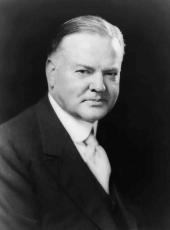
Address to the American Institute of Architects: Improvement of the National Capital.
I AM GLAD that the opportunity has come to me as President to contribute to impulse and leadership in the improvement of the National Capital. This is more than merely the making of a beautiful city. Washington is not only the Nation's Capital, it is the symbol of America. By its dignity and architectural inspiration we stimulate pride in our country, we encourage that elevation of thought and character which comes from great architecture.
Our Government in Washington has grown greatly during the past 15 years. We have a working force of nearly 70,000 employees as compared with 35,000 a score of years ago.
War and economic recovery have delayed us in providing even our bare necessities of office space. Nearly 25,000 employees are today in rented buildings or temporary structures built during the war which were expected to last but a year or two. Many of the buildings are insanitary. Above all, the departments are divided among scores of unworkable and scattered buildings. For instance, Agriculture is housed in 46 different places in the city and the Treasury in 27 places, Commerce in 20 places. We are paying rents and losing efficiency in sums far greater than the interest upon adequate buildings. Many of the buildings we occupy are an eyesore to the city. We have an authorized building program for, say, 18,000 employees, yet if we would satisfy even our present need, we should have new buildings to accommodate more than 30,000 Government workers.
Congress has authorized the beginning of a great program which must extend over many years. It is our primary duty to do more than erect offices. We must fit that program into the traditions and the symbolism of the Capital. Our forefathers had a great vision of the Capital for America, unique from its birth in its inspired conception, flexibility, [p.122] and wonderful beauty. No one in 150 years has been able to improve upon it.
The founders of the Republic also gave us a great tradition in architecture. In after years we have held to it in some periods and in others we have fallen sadly away from it. Although it is perhaps too early to envisage such a glorious future, I do hope to live to see the day when we shall remove from Washington the evidences of those falls from the high standards which would have been deplored by the founders of our Republic and have been deplored by the citizens of good taste ever since these transgressions.
Probably one of the major buildings which we regret most is the State, War and Navy Building. I have been vastly interested to find that the Congress of that day had a splendid taste, for they directed it to be the duplicate of the Treasury Building, but the administration of that day delivered it externally over to an architectural orgy. I have been lately advised that for a comparatively modest sum we can strip it of its function to represent the different types of architecture known to man and bring it back to the sound classic lines of the Treasury, as Congress intended. And this again points to the responsibility of the administration, for Congress is today, as then, giving generous authority and asking that we do our part in design and construction.
It is the wish and the demand of the American people that our new buildings shall comport with the dignity of the Capital of America, that they shall meet modern requirements of utility, that they shall fulfill the standards of taste, that they shall be a lasting inspiration. In architecture it is the spiritual impulse that counts. These buildings should express the ideals and standards of our times; they will be the measure of our skill and taste by which we will be judged by our children's children.
Mr. Mellon has insisted that the great responsibility before us is not one which can be discharged by any one individual. It must be the product of the common mind of many men, devout to secure for America the vast realization of the expression of our Nation. And I am confident that we have within the Nation the taste, skill, and artistic [p.123] sense to perform our task for our architects have already given to America the leading place in their great art.
It is on this national stage that the great drama of our political life has been played. Here were fought the political battles that tested the foundations of our Government. We face similar problems of our time, and here centuries hence some other Americans will face the great problems of their time. For our tasks and their tasks there is need of a daily inspiration of surroundings that suggest not only the traditions of the past but the greatness of the future.
Note: The President spoke at an evening meeting of the American Institute of Architects in the United States Chamber of Commerce Building. The meeting centered on the development of the city of Washington and included the unveiling of exhibition models of buildings to be erected in the Federal Triangle, authorized by legislation in 1926 (44 Stat. 630, 874). The meeting, portions of which were carried over national radio, was also attended by the planning groups involved and Members of Congress, the Cabinet, and the Supreme Court.
In the early 1920's, Mr. Hoover had served as a member of the American Civic Association's Committee of One Hundred on the Federal City. Subsequently, he worked closely with those responsible for the National Capital Park and Planning Commission and after 1926 he helped shape plans for the Federal Triangle development.
Herbert Hoover, Address to the American Institute of Architects: Improvement of the National Capital. Online by Gerhard Peters and John T. Woolley, The American Presidency Project https://www.presidency.ucsb.edu/node/209298

